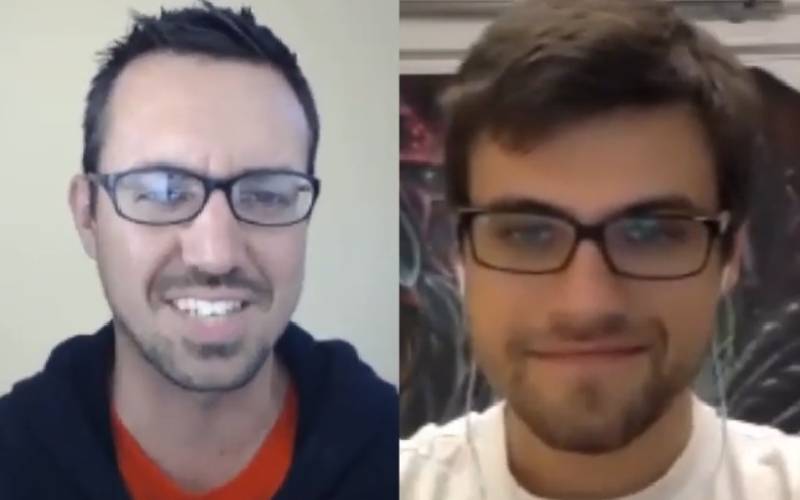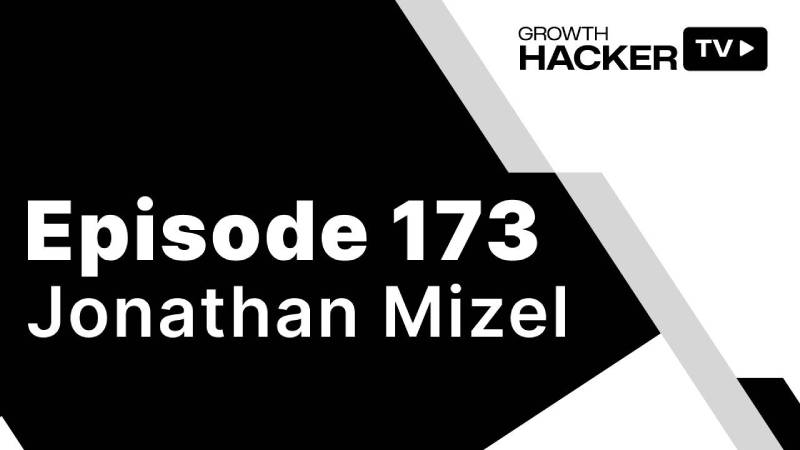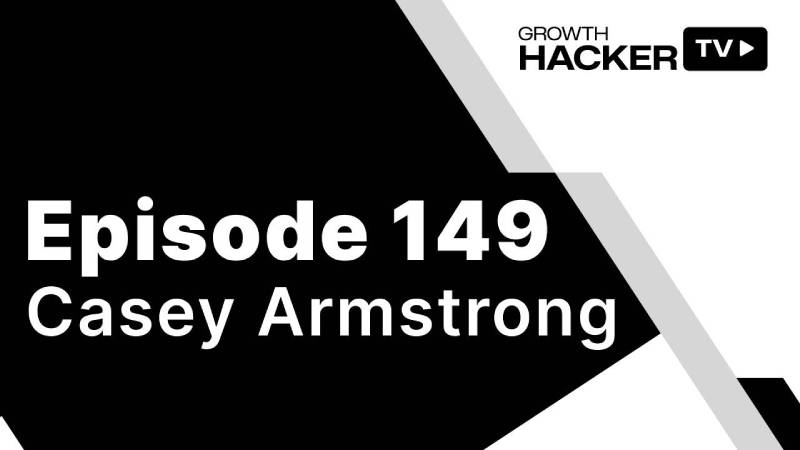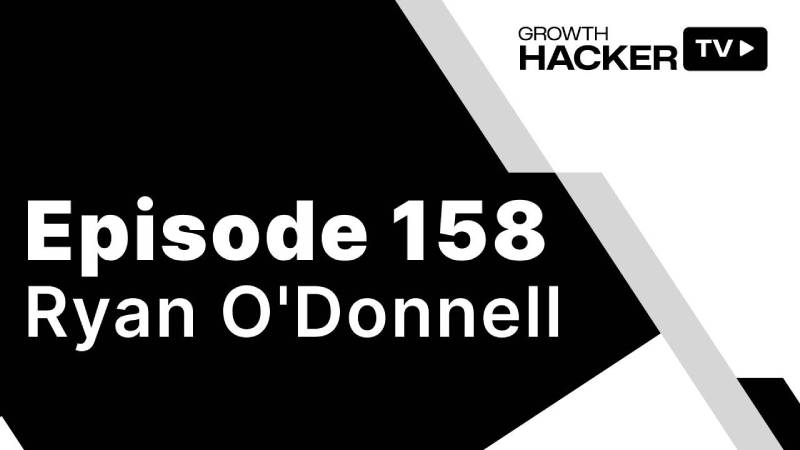Greg Pietruszynski specializes in customer acquisition for his clients. In this episodes, he takes me behind the scenes of his 3 most successful automated acquisition machines.
TOPIC GREG PIETRUSZYNSKI COVERS
→ He is the CEO and founder of Robots
→ He ran over 200 B2B marketing campaigns while running a social media agency with 15 employees
→ Campaigns were focused on user acquisition and performance marketing
→ Lessons learned: not specified in the conversation provided
→ His previous experience running a social media agency taught him the importance of focusing on quality over quantity and engagement over vanity metrics
→ His current company delivers warm leads to customers by taking care of everything that happens before a demo is scheduled with a potential customer
→ And a whole lot more
LINKS & RESOURCES
WATCH THE INTERVIEW

READ THE TRANSCRIPTION
Bronson: Welcome to another episode of Growth Hacker TV. I’m Bronson Taylor and today I have Greg with us. Now, usually I say their last name when I say their first name. Your last name is so difficult. I’m just going to have you say it. So your first name is Greg. What’s your last name?
Greg: The 13th guy? Yes. It’s perfect.
Bronson: Yeah, it is the great Joe from Poland. Which explains the last name, right?
Greg: Yes, that’s true.
Bronson: Yeah. So, Greg Petrossian. All right. There we go. Now, Greg, you are the CEO and founder of Robots, and we’ll get that in a second. But first, I want to ask you about your personal stuff for a second, because online, your profile says that you’ve ran over 200 B2B marketing campaigns. And just thinking about that many B2B marketing campaigns makes me exhausted. So first of all, what kinds of campaigns have you been running?
Greg: Okay. So those were basically mostly campaigns focused on user acquisition. Mm hmm. And the performance marketing, uh, mostly using social media. As I was running the social media agency myself with my 15 employees all together, so saying I was responsible for 202 campaigns means our company did more than 200, the B2B marketing campaigns. And of course, I was not personally involved in management of all of them, but I was definitely trying to get involved in the high level concept of each of those.
Bronson: Yeah. So as a social media agency, 200 different B2B campaigns that you’re kind of overseeing, what are the most important things that you walked away from that experience with seeing so many B2B social campaigns? What were the lessons you learned in that experience?
Greg: I would say that the first lesson I’ve learned marketers should get is to focus on the quality instead of the quantity. So in terms of social media, it was super easy to get focused on acquiring funds, for example, but not really on creating engagement. Mm hmm. Also, while acquiring new users to social applications, most of the people were interested in getting as many users as possible, but not really looking at the sites of how many users are active, how many users invite their friends to use the application, etc..
Bronson: Mm hmm. Did you have a hard time with your clients? Because they wanted to just vanity metrics, but you believed that engagement mattered. Was there always kind of friction there?
Greg: Of course, like a vanity metrics are like the the most difficult problem for every social media marketer, I suppose, because yeah, every customer is like our competition has more fans. Yeah.
Bronson: I mean, I didn’t know that, but I assumed that was the case. All right. Let’s talk about Girlboss a little bit. Girlboss is your current company. You’re the CEO and founder there. And it’s a very interesting concept. So I’m glad we get to kind of dove into it today. So first in kind of a high level, what do you all do? Ask robots.
Greg: So at the high level, we deliver warm leads to our customers. So basically we take care of everything. What happens before our customers have a demo scheduled with a potential customer?
Bronson: Okay. So when you say a warmly so if a company is working with you guys, they end up with an Excel document of leads once a week or once a month, and then they take it from there or kind of close the deal. Is that how it works?
Greg: Not really, because we outreach the prospects on behalf of our customers. So they only speak with the people who already said they’re interested in learning more about the product.
Bronson: All right. So they’re actually warm leads for that specific product, not just for that industry in general.
Greg: Yes. So it’s not like it’s not like purchasing a list of potential customers. But the, uh, the phrase world needs indicates that people already know what they want to buy the product.
Bronson: So is it fair to say that if you kind of think about like a funnel in conversion is somewhere in the middle of the funnel, you do everything right up to the actual conversion of them becoming a customer. And that’s where you hand it over to the company. Is that right?
Greg: Yes, exactly. This is how it works.
Bronson: I like this concept. It’s fun. It’s different. You know, usually have people that try to do the whole funnel or they just do traffic. You guys are somewhere in between where you actually get them up to the point of conversion. So that’s kind of fun now because.
Greg: Yeah, because because we believe that the customers do the best job on closing the deals, know product best. So you know, if you would like to get involved in the process of closing reduce, we would have to coach our sales reps, etc., etc. and we would never reach the same level of knowing the product as they do.
Bronson: Yeah. Is there ever a problem when you hand over that lead? Does the lead ever feel like, Oh, now I’m dealing with somebody else and it’s a jarring experience? Or is it a pretty smooth transition from warm lead to converted user?
Greg: It’s a pretty smooth transition because we pretend to be a part of our customer sales team.
Bronson: So they don’t know they’re getting handed off.
Greg: Yes, exactly.
Bronson: I like that. All right. Now you guys are just for SAS products, is that correct?
Greg: Yes. Yes. We focus on the SAS B2B market.
Bronson: And reason there. Why did you guys just pick SAS B2B? Because a lot of industries could use warm leads. So what made you kind of want to go there?
Greg: Because the like SAS companies, customers. Are accustomed to the online sales, you know? Mm hmm. So it’s it’s like the conversion rates are the best when you deal with this kind of product because, you know, people are used to buying out their application online or, you know, taking part in the trial or just seeing a demo of the product without an actual meeting.
Bronson: Etc.. So it’s easier to actually get a warm lead for a SAS company because of the kinds of customers you’re dealing with. Yes. Yeah. Okay. I gotcha. Now, on your site, it says that you all create automated customer acquisition. So let me ask about that. Is it automated to the client because they don’t have to deal with it anymore? Or do you guys actually automated internally so that eventually you don’t have to deal with it either? It’s just happening on its own? Well, what exactly is automated about it?
Greg: Okay. So definitely it’s automated from the customer side so they don’t care about anything. We do the job and of course it’s helping me to do that because otherwise we wouldn’t be able to work with so many customers.
Bronson: I gotcha. All right. So you create initially you have to do some work, but eventually you get kind of an automated system just pouring in warm leads into these businesses that you’re working with.
Greg: Yes, exactly. Now we operate the software ourselves, but we are also working on the SAS platform, which will be released in a couple of months.
Bronson: And that will kind a self-serve thing.
Greg: Yes, exactly.
Bronson: So you’ve actually done the process enough. You know what’s going to work and you can actually just make a product out of it.
Greg: That is the plan.
Bronson: I like that. That’s cool. So let’s walk me through the actual box process. So first, you know, you guys are dealing with SAS clients. Is a part of that reason because they have a high lifetime value and you know that you can make the money you need to. There is that kind of the stage one. Make sure they have customers worth money.
Greg: Yes. Yes, that’s true. You know, you need to generate a certain amount of revenue from your customers to implement our sales process because it’s very complex. And. And we have to make sure that our customers will experience the positive ROI on our services.
Bronson: Gotcha. And now you said you’ve done it enough that it’s going to become its own product. So what exactly are you doing? I mean, give me as much as you can about what that process really is. Are you using paid traffic? Is it inbound? Is it email marketing? Is it social? Is it something totally different that I’ve never even heard of? Like, what are you guys actually doing to get people out in the world to become these warm leads such that it’s eventually going to be its own product?
Greg: Okay, so we start from generating a list of potential customers that meet the qualification criteria. Mm hmm. And then we also automate the outreach. So we combine social media outreach, email outreach in one tool.
Bronson: So we see when you say you make a list of potential customers, it’s actually a list of names. It’s not just a list of we want a person with this kind of income, with this size family. You’re actually listing names.
Greg: Yes, exactly. Name listing. Every potential customer there is on the market. And we can find that.
Bronson: Sure. And you’re you’re searching Twitter for that. You’re searching LinkedIn for that. Where are you going to to kind of generate that list?
Greg: Okay. So we are cross-checking data from different databases. So basically, we are using whatever data we can find.
Bronson: I gotcha.
Greg: Which means, of course, LinkedIn for some customers, it’s also a dump of our sites. It’s Yelp. So we can plug in different data sources to get us good qualification and possibilities as we can.
Bronson: I gotcha. All right. So you use all these different platforms, you get a list of people. And part of what your tool that you’re building is going to do is kind of automate getting that list. So you’re pulling together all those APIs to do it automatically, eventually, right?
Greg: Yes.
Bronson: Yes, that’s right. So you get the list. Then what do you do with that list? You said it’s a mix of kind of reaching out through email, reaching out through social is the eventually the next step is you just get in touch with them somehow.
Greg: Yes. Yes, exactly. This is how it works. So what? We have a list. Then we have to use as many channels as possible to convert as many of the prospects into demos and hopefully into paying customers.
Bronson: Okay, so you say you convert to a demo, so you reach out and it is an email that says, hey, watch this video demo, or is it a, hey, you might be interested in this product? Can we tell you more about it? Like, what is your call to action that first time? Because they don’t know who you are. It’s a cold email or it’s a cold social interaction. So what is the first sale you’re trying to get with them?
Greg: Okay. So basically it is not the cold, the email and this is our unique value here because we use social media to start the little interaction with our prospects before they get an email. So there is there is already some, some context you can refer to when sending the email. And it it helps us to achieve conversion rates to positive answers even higher than 50%.
Bronson: So it’s always something like, hey, I’m the guy that tweeted at you a couple of days ago on Twitter and I have this thing that you might be interested in. Do you want to talk about it? Is that what the email looks like?
Greg: Yes, exactly. And you don’t have to be a you know, to sell it because you already know that this customer is a great fit for your product. So you just talk to him on the phone and get him on the phone. It’s it it is an easy sell.
Bronson: Okay, so your goal is to get them on the phone.
Greg: Yes. Our customers.
Bronson: All right. And so then when you give those warm leads to the client, it’s actually here’s their name, here’s the date when they want to go on a phone with somebody and here’s their phone numbers, that kind of thing.
Greg: Yes, exactly.
Bronson: And then they actually have someone on their side get on the phone and actually walk them through their product. And then you’ve got a really high chance of selling because of the whole funnel. Just warmed them up to the point they’re actually on the phone.
Greg: Yes.
Bronson: I see what you’re doing. I like it. Okay. I had to dig in because I wasn’t sure about how this whole process actually worked. Do a lot of SAS companies have the ability to get on the phone that many times? Like they’re able to do that or they like doing that? What’s the what’s the response from that side of the market?
Greg: Okay. So right now we focus on the customers who provide and supply enterprise plans.
Bronson: Okay. So they have the ability to have a sales team.
Greg: Yes. They have people who are trying to provide demos to potential customers because to be honest, they’re not. No, none of the enterprise customers will ever buy it like a piece of software worth a thousand or $2,000 a month without having any personal contact with it. It is very unlikely.
Bronson: Yeah, no, it makes sense. And so now, now I’m starting to see kind of why your numbers work the way they do, because you charge I think it’s $150 per warm lead, but that’s because the lifetime value of our customer is way higher than $150. So that’s why the numbers actually work, where if it’s a small SaaS company or a startup, they’re going to have a hard time using it.
Greg: Yes, that’s true. But we calculated the pricing to provide our customers with at least three or 400% of ROI on those services. And we stick to that. If we cannot meet this metric, we will not do a project with a customer whether we have a self operated platform. Then of course everyone can use it. And the call to action then might be, for example, to try a registration instead of the demo. Mm hmm. And this way, we could. We can go also go a bit down the market.
Bronson: Yeah. Now, what is. Tell me some of the big success stories, you know, and you don’t have to name their names in all of your clients. But what are a few of the stories where this just worked really well for them and it was really a game changer for them?
Greg: So basically what we are doing, we are trying to find a creative way of of finding customer ideal customers that verify this. No, no. And for example, some of the customers are targeting a very specific niche who is using a very specific technology somewhere in the back end of their software. And basically, you cannot see from outside what technology they’re using. So that’s why we started cross-checking the data with a job offer site, because if a company is hosting a job offer on IWC, for example, they have to use it internally. So so this is on the qualification side. Also, we have like a very cool machine for Twitter communication automation. So we found out that if you focus on the conversations that include links and go around sharing content, then the chance of getting somebody involved in the conversation is the highest.
Bronson: If you share content directly to them on social media.
Greg: So yes. So imagine that you are sharing on, for example, ten best tools to improve the social media strategy. So we have a tool that extract the keywords from, from this link and matches in related content, then wraps it up with a template we are ready for you written and, and then we have a ready to use tweet, answer to your tweet and get you into the conversation.
Bronson: It’s awesome. If people only knew how much of Twitter conversations weren’t actually happening, that is like they’re happening.
Greg: But what we are not doing is those automated favorites or automatic direct messages because it doesn’t feel right. It feels a bit too spammy.
Bronson: So yeah.
Greg: We try to give it to.
Bronson: People because nobody knows it’s not real. It looks like that’s the only difference and nobody can tell. That’s awesome. You guys are doing some cool stuff with data on how you’re pulling together, that’s for sure. So that’s it’s a cool product you have, and I think you guys are going to have a lot of success as you move forward. Let’s talk about SAS growth kind of in general for a moment. You know, if someone’s watching or listening to right now, I mean, here you are, the guy that grows SAS companies. What would you tell them to start? Should they you know, if they don’t want to use you guys, should they do the same thing on their own? Just have real engagement on social media prospect, who they’re trying to sell to and try to get them on the phone. Should that be something other people try to tackle or should they just go to paid traffic or should they just go somewhere else? Where do you think somebody should start when they’re really trying to grow their userbase? Do you have any ideas on that?
Greg: If you if you create the SAS B2B software, it’s always best to go after like a limited number of high value customers. You know, they a great fit. So you can spend a lot of time trying to convert them to your customers because it’s much better to acquire one one customer that will pay you $1,000 than the 50 that will pay it be 20 for example. So yeah, so, so I would, I would try to advice to focus on the enterprise customers or have high value customers on the beginning. And this is where you can use the tactics I mentioned also.
Bronson: Yeah.
Greg: So, so Google is trying to, trying to put a lot of effort in personalizing the communication and slowly converting your list into into your customers. Yeah.
Bronson: And even, you know, even though they don’t have all these automated things like you guys now have, they could do this just, you know, with real interaction because if they’re only just going after a certain number of people, they have real conversations with them. They follow up with them through email, try to get them on the phone. They can do that all by hand and reach out to 30 or 40 people, you know, each week if they’re trying to really get something started and they could.
Greg: Yes, that’s true. And also in the beginning, it is very important to get feedback from your users. So this contact, the personal contact really helps to get a lot of feedback that is really useful for product improvement.
Bronson: Yeah. No, I really like your calls process. It’s something different, which is welcome. And so I have a few final questions for you here. What are what are you working on today at Girlboss when this interview is over? It’s a question of an asking people lately, and it seems they have fun responses because you get to see kind of a window into their life today. So what are you working on after this? Over.
Greg: I have a few meetings scheduled here in San Francisco. And the. And the. Of course, uh, we need to move forward quite, quite fast to the final product. So there are those daily stand ups. And then discussing the progress.
Bronson: Sounds good.
Greg: A new idea?
Bronson: Absolutely. All right. Last question. What is the best advice you have for any startup that’s trying to grow? And I think I might know what you’re going to say, but go ahead anyway.
Greg: I would suggest to to focus on solving one problem on the one market and then to use one user acquisition channel or customer acquisition channel. Because the truth is that there is always not enough time for anything at the. So it’s best to keep it really simple.
Bronson: Yeah. Well, Greg, thank you again for coming on growth. RTV This has been an awesome interview.
Greg: Thank you very much.
Ready To Grow Your Startup?
Get the strategies, motivation, and in-depth interview with all the details every week!




